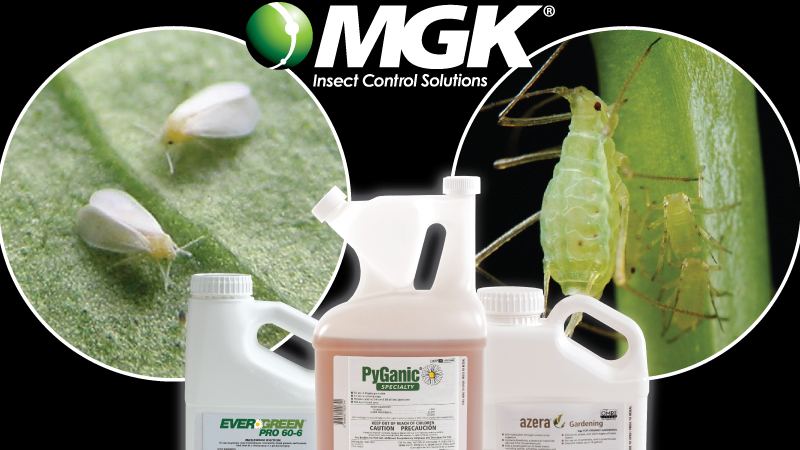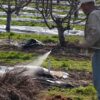Aphids and whiteflies actually have a lot in common. Whiteflies are not actually flies at all. In fact, both aphids and whiteflies are in the order Hemiptera and suborder Sternorrhyncha so they are fairly closely related, as far as insects go, and many of the control techniques work similarly on them. They are similar in size, both soft bodied, and have piercing sucking mouthparts. Some differences are that whiteflies are winged and although aphids are sometimes winged, most often they are not. Whiteflies often are covered in tiny waxy scales giving them that bright white appearance, while aphids are not but come in a variety of colors such as yellow, green, black, and even pink. If you are unsure about whether you have whiteflies or aphids, you can take them to an entomologist for identification.
Aphids and whiteflies seem to be an ever present or at least frequently reoccurring pest that every grower I know has dealt with at one time or another. You are not alone! These tiny yet fierce little creatures can wreak havoc on your plants.
There are many different tactics and options to consider when trying to manage these pests including cultural controls, biological controls, exclusion, and physical removal. For this article we will focus on MGK’s botanical insecticides. Contained in your arsenal of botanical options are EverGreen Pro, PyGanic Specialty, and Azera Gardening. They have some key differences I will discuss below.
Botanical Whitefly and Aphid Control Products:
EverGreen® Pro 60-6 is a botanical product that contains the synthetic synergist piperonyl butoxide (PBO) as well as the botanical active ingredient pyrethrins. The product is 60% PBO and 6% pyrethrins. They work together to create a more effective insecticide for the whiteflies and aphids. The PBO binds to enzymes and prevents them from breaking down the active ingredient inside the insect. This allows the insecticide to have a more powerful and lethal effect on the insects without adding more insecticide.
PyGanic® Specialty is an OMRI listed product containing 5% pyrethrins. If you want or need an organically certified product for professional plant production, then this one will work for you. It has the same active ingredient as EverGreen Pro 60-6, but without the added synthetic synergist.
Azera® Gardening is an OMRI listed combo product containing azadirachtin and pyrethrins. It contains 1.2% azadirachtin and 1.4% pyrethrins. The dual action active ingredients provide different modes of action that can combat potential resistance or delay the development of resistance. Azadirachtin has a little bit longer half-life than pyrethrins in most situations although still breaks down fairly quickly. Not for use on plants being grown for sale.
When picking one of these insecticides, consider them in regards of all the factors that are important to you. Some of those factors could be OMRI listing, multiple modes of action, extra killing power of a synergist, and let’s not forget cost. To effectively consider costs, find the labels and look at how much a finished gallon per 1,000 ft2 will cost at the rate you want to apply and how many total finished gallons that container will make then compare amount of area treated per insecticide container. That will give you a better picture of cost per application rather than comparing concentrates side by side that may have different mix rates.
With all three of these botanical products there is no pre-harvest interval, with a few limited restrictions for things like cotton and rice. Therefore, with EverGreen Pro 60-6 or PyGanic Specialty you can spray in the evening and ship or sell the plants or crop the next morning. With Azera Gardening there is also no pre-harvest interval but it is not for use on plants being grown for sale. Remember to read the label carefully for the product you choose to make sure you are following all label instructions.
How and When to Apply the Products:
When do you need to apply these products? Spray as soon as you detect an infestation. It is best to nip the pest problem in the bud so to speak… or maybe literally, Ha! Seriously though don’t let the problem get out of hand. It is much easier to deal with a new infestation on a few plants (hot spots) as opposed to waiting until all plants in a planting have high pest numbers with serious damage and crop losses.
When you do find a problem and decide to spray, coverage is key. Make sure to get all the surfaces where pests may be resting or harboring. Undersides of the leaves are especially important. These insecticides are contact insecticides and they have to contact the insect in order to be effective. Multiple treatments may be necessary to get all the insects. Whiteflies and aphids are tiny and whiteflies especially are mobile and it is difficult to get all of them on the first spray. Spraying in the evening when there is less UV light can slightly extend the period of efficacy of pyrethrins. Night spraying also avoids getting insecticide on most pollinators that visit flowers during daylight.
When should you not apply these products? Do not apply them as a preventative when no pests are present because it is a waste of product. You may also quickly reach the maximum numbers of sprays allowed on a crop per season and not be able to use the product later when pests appear. Most if not all botanical based insecticides have very short period of efficacy and most insects are killed after getting covered with insecticide or on contact. Because UV light breaks them down so quickly you cannot use them to kill insects that may arrive after a spray. Pyrethrins have about an 11 hour half-life outside in direct sun. UV light is the quickest way to break down the product, but other break down mechanisms include microbes and oxidation.
Monitoring for pests is one of the most important things you can do to maintain the health of your plants. If you don’t know there is a problem, you certainly can’t do anything about it. So make a weekly schedule and look for aphids and whiteflies on yellow sticky cards (1 card per 1,000 ft2 of bench) and also randomly inspect for these pests on all parts of the more susceptible plant varieties, new plant cuttings and weeds in all parts of the greenhouse, especially by fans and doors. Mark each pest hotspot with flagging for future insecticide treatment and/or inspection. Also, implement various sanitation practices to minimize pests that may develop on weeds under benches, around greenhouse exteriors and mulch on floor.
Sandra Sleezer
MGK – Technical Service Coordinator
January 12, 2018
Acknowledgements: Sandra would like to thank Dr. Donn Johnson, professor of entomology at the University of Arkansas, for his contributions in editing and improving this article to the benefit of those who will read it.
© 2018, Mycorrhizal Applications LLC







